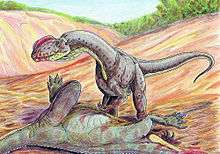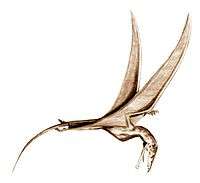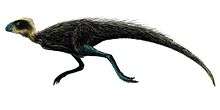Sinosaurus
| Sinosaurus Temporal range: Early Jurassic, 201–196 Ma | |
|---|---|
| | |
| Mounted cast | |
| Scientific classification | |
| Kingdom: | Animalia |
| Phylum: | Chordata |
| Class: | Reptilia |
| Clade: | Dinosauria |
| Order: | Saurischia |
| Suborder: | Theropoda |
| Clade: | Tetanurae |
| Genus: | †Sinosaurus Young, 1948 |
| Type species | |
| †Sinosaurus triassicus Young, 1948 | |
| Synonyms[1][2] | |
| |
Sinosaurus (meaning "Chinese lizard") was a tetanuran theropod dinosaur which lived during the Early Jurassic Period. Its fossils were found in the Lufeng Formation, in Yunnan Province, China. It was a bipedal carnivore. It was approximately 5.6 metres (18 feet) long.
Description
.jpg)
According to Carrano et al. (2012) D. sinensis, now considered to be the same as Sinosaurus triassicus, can be distinguished based on the fact that a vertical groove is present on the lateral premaxilla adjacent to contact with the maxilla.
Sinosaurus is the only "dilophosaurid" known from a complete braincase. Cryolophosaurus, Dilophosaurus, Zupaysaurus and Coelophysis kayentakatae are all known from partial braincases. Two partial braincases were found before 2012, and are probably mostly complete, except that large sections are obscured by sediments. In 2011, an exceptionally well-preserved braincase was found, only missing the frontal bones and orbitosphenoid.[3]
Discovery and naming
KMV 8701 was originally discovered in 1987. The specimen was identified as a new species, and was named Dilophosaurus sinensis. Then in 1994, during a field expedition, a more complete specimen was found, and was assigned to the same species. In 2003, Dong Zhiming studied the material of Sinosaurus, finding it to be quite similar to Dilophosaurus sinensis. As Sinosaurus was named earlier, by Young in 1948, "Dilophosaurus" sinensis became its junior synonym.[1] The composite term Sinosaurus comes from Sinae, the Latin word for the Chinese, and the Greek word sauros (σαυρος) meaning "lizard"; thus "Chinese lizard". The specific name, triassicus, refers to the Triassic, the period that the fossils were originally thought to date from. Sinosaurus was described and named by Chung Chien Young, who is known as the 'Father of Chinese Vertebrate Paleontology', in 1948.[4]

Over the years, paleontologists referred additional specimens to D. sinensis which are now assigned to Sinosaurus. Dong (2003) referred specimen LDM-LCA10 which consists of a skull and an incomplete skeleton.[1] In 2012, Xing referred two individuals, ZLJ0003 which consists of a partial skull and an incomplete skeleton, and ZLJT01 which is a juvenile individual that consists of a premaxillary fragment, an incomplete maxilla, a maxillary fragment, a lacrimal, both frontals, both parietals, an incomplete braincase, an incomplete dentary, an atlantal intercentrum, two dorsal rib fragments, and a partial proximal caudal neural arch, to Sinosaurus.[3]
The holotype, IVPP V34, was found in the Lower Lufeng Formation, and consists of two maxillary (upper jaw) fragments, four maxillary teeth, and a lower jaw fragment with three teeth. The teeth are laterally compressed, and feature fine serrations both at their anterior and posterior edges. The teeth are also variable in size and are curved backwards. This material is too fragmentary to determine the length and weight of this dinosaur. Over the years, other fossils were referred to Sinosaurus, some of which were material that was shown to belong to two sauropodomorphs.[5][6] The fossils include a postcrania,[7] with a sacrum with three preserved sacral vertebrae. The material assigned to "Sinosaurus postcrania" includes a mix of plateosaurid and melanorosaurid elements. All the material from the Red Beds block has now been reassigned to Jingshanosaurus[8]
Shaojin Hu (1993) assigned specimen KMV 8701 to Dilophosaurus sinensis.[9] In 2013, a study by Currie et al., confirmed that D. sinensis was the same animal as Sinosaurus triassicus[10] Specimen KMV 8701 consists of a skull (measuring 525 mm), and is nearly complete. The specimen KMV 8701 is about 5.6 m (18 ft) long, meaning Sinosaurus was about that length.[1] KMV 8701 has been assigned now to Sinosaurus, but the specimen still lacks sufficient description and preparation.[3] In 2012, a new specimen of Sinosaurus was described, and was found to represent a new species.[3]
Classification
Originally thought to be a coelophysoid related to Dilophosaurus and Cryolophosaurus, Oliver Rauhut in 2003 showed Sinosaurus to be a more advanced theropod, related to Cryolophosaurus and "Dilophosaurus" sinensis.[11] In 2013, in an unpublished work, Carano agreed that Sinosaurus is a theropod.[12] Sinosaurus has been considered a nomen dubium in a few works,[9][13][14] although now that "Dilophosaurus" sinensis is referred to it, it is considered valid.[1][2]
Dilophosaurus sinensis was shown to be a junior synonym of Sinosaurus in 2003.[1] It is possibly closer to the Antarctic theropod Cryolophosaurus, based on the fact that the anterior end of the jugal does not participate in the internal antorbital fenestra and that the maxillary tooth row is completely in front of the eye socket. D. sinensis was exhibited in 1998 at Dinofest in Philadelphia.[15] Although the skull of D. sinensis sports large nasolacrimal crests superficially like those reconstructed in D. wetherilli, features elsewhere in the skeleton suggest it is closer to tetanuran theropods.[8] Rauhut (2003) regarded D. sinensis as a basal tetanuran most closely related to Sinosaurus and Cryolophosaurus.[11] Lamanna et al. (1998b) examined the material ascribed to D. sinensis and found it to be synonymous with Sinosaurus triassicus.[16] This cladistic finding was confirmed in 2003 by Dong.[1][2][10]
The Lufeng Dinosaurian Museum discovered a new specimen of Sinosaurus (ZLJT01) in 2007 from the Lufeng Basin. It consists of an incomplete skull and other postcranial fragments. Phylogenetic analysis of this specimen, demonstrates that Sinosaurus is a more derived theropod, and is not the most basal dilophosaurid, as held by Smith et al.[2] A cladogram was identified by Christophe Hendrickx and Octávio Mateus. It placed Sinosaurus as the sister taxon to Cryolophosaurus, and together they were the most basal tetanurans.[17]
| Theropoda |
| ||||||||||||||||||||||||||||||||||||||||||||||||||||||||||||||||||||||||||||||
| |
Paleobiology

Crest function
Sinosaurus and Dilophosaurus both possess dual crests. However, it was found that the crests could not be used in combat.[3]
Feeding
The skull of Sinosaurus has a deep notch between the premaxilla and maxilla. Dong (2003) proposed that the notch was used to house jaw muscles, giving Sinosaurus a powerful bite. Based on the estimated power of its jaws, Sinosaurus might have either been a carnivore or a scavenger. Dong suspected that the premaxilla was covered in a narrow, hooked beak, that was used to rip open skin and abdominal flesh. He also thought that the crest would have been used to hold open the abdominal cavity while feeding. Dong studied the feet of Sinosaurus as well, finding a resemblance with the feet of modern vultures. The feet of Sinosaurus were probably adapted to help it feed on large-bodied animals, such as prosauropods.[1]
Paleopathology
A study by Xing et al. (2013) examined the effect of the traumatic loss of teeth on the dental alveolus (the socket in the jaw where the roots of teeth are held) in dinosaurs. Sinosaurus is the first dinosaur where remodeling of the alveolus in the jaw was observed.[2] The authors concluded that this finding "contributes to mounting evidence suggesting theropods were highly resilient to a broad spectrum of traumas and diseases."[2] The dental alveolus found on Sinosaurus is the first documented dental pathology found on a dinosaur.[3]
Paleoecology
Provenance and occurrence

The type specimen of Sinosaurus triassicus IVPP V34 was recovered in the Zhangjiawa Member of the Lufeng Formation, in Yunnan, China. These remains were discovered at the Dark Red Beds that were deposited during the Sinemurian stage of the Jurassic period, approximately 196-183 million years ago. Several other discoveries referred to Sinosaurus were made in the Zhangjiawa Member: specimens IVPP V97 (postcrania), IVPP V36 (teeth), IVPP 37 (teeth), IVPP V88 (ilium), IVPP V35 (teeth and postcranial bones), IVPP V100 and IVPP V48 (teeth and postcranial bones) discovered in 1938 by M. Bien & C.C. Young,[18] FMNH CUP 2001-2003 discovered by E. Oehler and Hu.[19] Specimens FMNH CUP 2097, FMNH CUP 2098, FMNH CUP 2004, FMNH CUP 2005 were discovered in 1948 by M. Bien & C.C. Young at Zhangjiawa Member, as well.[20] Sinosaurus sp. fossils have been found in the Zhenzhuchong Formation, and were previously thought to be a poposaur, although they might have only been from the equivalent Lufeng Formation.[21]
Specimen IVPP V504, referred to Sinosaurus, a maxilla with four teeth, was collected by Lee in the 1940s, in the Dull Purplish Beds of Shawan Member of the Lufeng Formation, that were deposited during the Hettangian stage of the Jurassic period, approximately 201-199 million years ago. Several other discoveries were made in the Shawan Member: parts of two skeletons attributed to Sinosaurus were discovered by Sou in 1956,[22] specimen IVPP V279 (tooth) was discovered by C.C. Young in 1938, in dark red clayish sandstone, and specimen IVPP V381 (several teeth) was discovered by C.C. Young, in blue mudstone.[18] The D. sinensis remains, KMV 8701, a nearly complete skeleton, now referred to Sinosaurus, were recovered in the Shawan Member of Lufeng Formation. This material was discovered in 1987 in the Dull Purplish Beds that were deposited during the Hettangian stage of the Early Jurassic, approximately 201-199 million years ago.
Fauna and habitat
In the Lufeng Formation, Sinosaurus shared its paleoenvironment with therapsids like Morganucodon, Oligokyphus, and Bienotherium; archosaurs like Pachysuchus; diapsids like Strigosuchus; crocodylomorphs like Platyognathus and Microchampsa; the early mammal Hadrocodium; and other early reptiles.[23] Contemporary dinosaurs include indeterminate sauropods; the early thyreophorans Bienosaurus lufengensis and Tatisaurus oehleri; the supposed chimeric ornithopod "Dianchungosaurus lufengensis"; the prosauropods Gyposaurus sinensis, Lufengosaurus huenei, L. magnus, Jingshanosaurus xinwaiensis,[23] Kunmingosaurus wudingensis, Chinshakiangosaurus chunghoensis, Yunnanosaurus huangi, "Y." robustus, and an unnamed taxon; and the theropods Lukousaurus, Eshanosaurus, and Coelophysis sp.
Changpeipus footprints have been found in the Lufeng Formation.[3] In 2009, a study led by Li-Da Xing found that footprints from the Lufeng Formation were unique among ichnogenera, and named the footprints Changpeipus pareschequier. The study hypothesized that they were produced by a coelophysoid; there are many possible trackmakers, however, including both Sinosaurus and Coelophysis sp.[14]
References
- 1 2 3 4 5 6 7 8 Dong, Z.M. (2003). "Contribution of New Dinosaur Materials from China to Dinosaurology" (PDF). Memoir of the Fukui Prefectural Dinosaur Museum. Beijing: Fukui Prefectural Dinosaur Museum. 2: 123–131.
- 1 2 3 4 5 6 Xing, L.D.; Bell, P.R.; Rothschild, B.M.; Ran, H.; Zhang, J.P.; Dong, Z.M.; Zhang, W.; Currie, P.J. (2013). "Tooth loss and alveolar remodeling in Sinosaurus triassicus (Dinosauria: Theropoda) from the Lower Jurassic strata of the Lufeng Basin, China" (PDF). Chinese Science Bulletin. Springer-Verlag. 58 (16): 1931–1935. doi:10.1007/s11434-013-5765-7. ISSN 1861-9541.
- 1 2 3 4 5 6 7 Xing, L.D. (2012). "Sinosaurus from Southwestern China". Department of Biological Sciences, University of Alberta. Edmonton: 1–286.
- ↑ Young, C.C. (1948). "On two new saurischians from Lufeng, Yunnan". Bulletin of the Geological Society of China. Acta Geologica Sinca. 28 (1–2): 75–90. doi:10.1111/j.1755-6724.1948.mp281-2007.x.
- ↑ Walker, A.D. (1964). "Triassic Reptiles from the Elgin area: Ornithosuchus and the origin of Carnosaurs". Philosophical Transactions of the Royal Society of London. Series B, Biological Sciences. The Royal Society. 248 (744): 53–134. doi:10.1098/rstb.1964.0009. JSTOR 2416617.
- ↑ Young, C.C. (1951). "The Lufeng saurischian fauna in China". Palaeontologica Sinica. C (13): 1–96.
- ↑ Glut, D.F. (2003). Dinosaurs, The Encyclopedia: Supplement 3. McFarland & Company. p. 495. ISBN 0-7864-1166-X.
- 1 2 Weishampel, D.B.; Dodson, P.; Osmolska, H. (2004). The Dinosauria (Second ed.). Berkeley: University of California Press. pp. 244–252. ISBN 0-520-24209-2.
- 1 2 Irmis, Randall (2004-12-22). "First Report of Megapnosaurus from China" (PDF). PaleoBios. 24 (3): 11–18.
- 1 2 Currie, Xing, Wu and Dong, in prep. "Anatomy and relationships of Sinosaurus triassicus (“Dilophosaurus sinensis”) from the Lufeng Formation (Lower Jurassic) of Yunnan, China".
- 1 2 Rauhut, O.W.M. (2003). "The interrelationships and evolution of basal theropod dinosaurs. Special papers in palaeontology 69". The Palaeontological Association: 215.
- ↑ M. T. Carrano. 2013. Taxonomic opinions on the Dinosauria.
- ↑ Glut, D.F. (2006). Dinosaurs, The Encyclopedia: Supplement 4 (4 ed.). McFarland & Company. p. 139. ISBN 0-7864-2295-5.
- 1 2 Xing, L.D.; Harris, J.D.; Toru, S.; Masato, T.; Dong, Z.M. (2009). "Discovery of Dinosaur Footprints from the Lower Jurassic Lufeng Formation of Yunnan Province, and new observations on Changpeipus" (PDF). Geological Bulletin of China. 28 (1): 16–29. ISSN 1671-2552.
- ↑ Glut, D. F. (1999). Dinosaurs, the Encyclopedia, Supplement 1: McFarland & Company, Inc., 442pp.
- ↑ Lamanna, M. C., Holtz, T. R. Jr, and Dodson, P., 1998, A reassessment of the Chinese Theropod Dinosaur Dilophosaurus sinensis: Journal of Vertebrate Paleontology, Volume 18, Supplement to Number 3. Abstracts of papers. Fifty-eighth annual meeting, Society of Vertebrate Paleontology, Snowbird Ski and Summer Resort, Snowbird, Utah, September 30-October 3, 1998, p. 57a.
- ↑ Hendrickx, C.; Mateus, O.V. (2014). Evans, Alistair Robert, ed. "Torvosaurus gurneyi n. sp., the Largest Terrestrial Predator from Europe, and a Proposed Terminology of the Maxilla Anatomy in Nonavian Theropods". PLoS ONE. 9 (3): e88905. doi:10.1371/journal.pone.0088905. PMC 3943790
 . PMID 24598585.
. PMID 24598585. - 1 2 M. N. Bien. 1940. Discovery of Triassic saurischian and primitive mammalian remains at Lufeng, Yunnan. Bulletin of the Geological Society of China 20(3/4):225-234
- ↑ D. J. Simmons. 1965. The non-therapsid reptiles of the Lufeng Basin, Yunnan, China. Fieldiana: Geology 15(1):1-93
- ↑ B. Patterson and E. C. Olson. 1961. A triconodont mammal from the Triassic of Yunnan. In G. Vandebroek (ed.), International Colloquium on the Evolution of Lower and Non Specialized Mammals. Koninklijke Vlaamse Academir voor Wetenschappen, Letteren en Schone Kunsten can Belgie 129-191
- ↑ Xing, L.D.; Lockley, M.G.; Chen, W.; Gierlinski, G.D.; Li, J.J.; Persons IV, W.S.; Matsukawa, M.; Ye, Y.; Gingras, M.K.; Wang, C.W. (2013). "Two theropod track assemblages from the Jurassic of Chongqing, China, and the Jurassic Stratigraphy of Sichuan Basin" (PDF). Vertebrata PalAsiatica. 51 (2): 107–130. ISSN 1000-3118.
- ↑ C.-C. Young. 1966. On a new locality of the Lufengosaurus of Yunnan. Vertebrata PalAsiatica 10(1):64-67
- 1 2 Y. Zhang, and Z. Yang. (1995). A new complete osteology of Prosauropoda in Lufeng Basin, Yunnan, China. Yunnan Publishing House of Science and Technology, Kunming, China 1-100. [Chinese]
External links
| Wikimedia Commons has media related to Sinosaurus. |
| Wikispecies has information related to: Sinosaurus |
- Information on Sinosaurus and other early dinosaurs at Thescelosaurus



